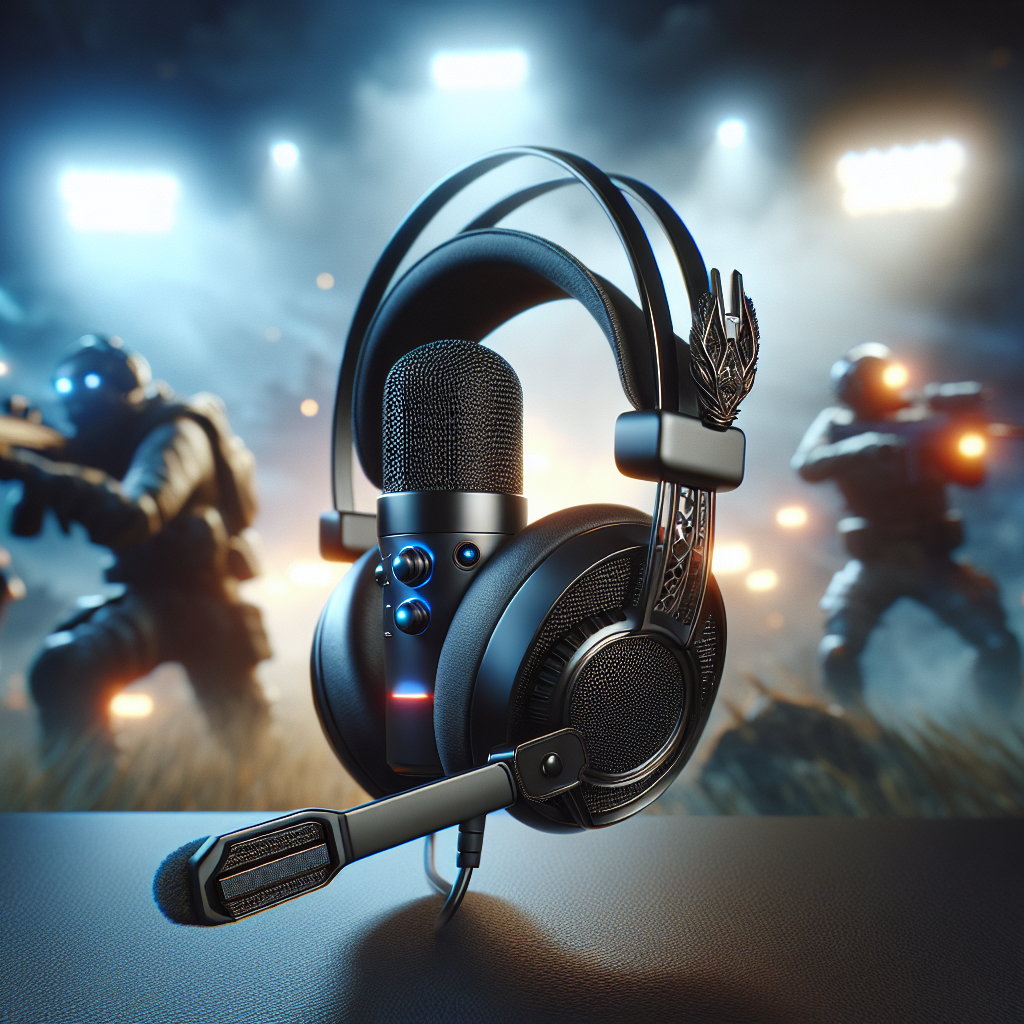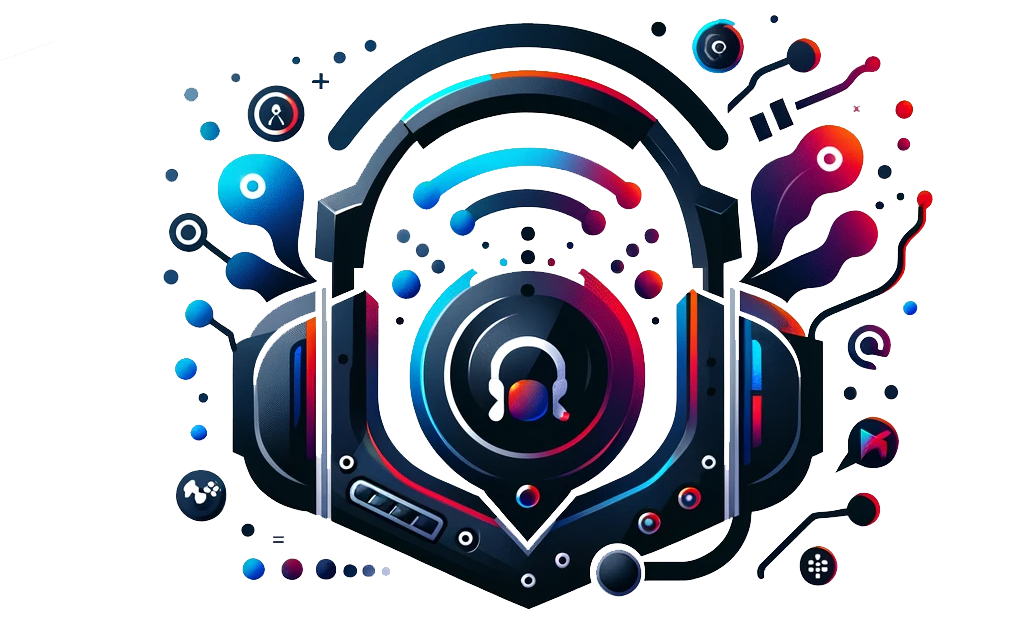Imagine yourself fully immersed in a thrilling online gaming experience with your closest friends, executing epic strategies and coordinating precise movements. Suddenly, you speak into your gaming headset mic, but instead of clear and crisp communication, your voice comes out distorted and muffled, leaving your teammates puzzled. In the world of gaming, a good microphone quality in your headset is not just a luxury; it is a necessity. Ensuring that you have the right microphone can make all the difference in effective team communication and enhancing your overall gaming experience.

Factors to Consider for Microphone Quality
When looking for a gaming headset, it is important to consider several factors that contribute to the overall microphone quality. These factors can greatly impact your gaming experience and the clarity of communication with other players. Here are some key factors to consider:
Noise cancellation
One of the most important factors to consider for microphone quality is noise cancellation. This feature helps to reduce unwanted background noise and ensures that your voice comes through clearly. Whether you are playing in a noisy environment or streaming content, noise cancellation can make a big difference in making your voice stand out and improving overall communication.
Clarity of audio
The clarity of audio refers to how well the microphone reproduces your voice and eliminates any distortion or muffled sounds. A good microphone should accurately capture and transmit your voice, ensuring that your teammates can hear you clearly without any difficulty. Clear audio is crucial in multiplayer games where effective communication is vital for teamwork and strategizing.
Frequency response
Frequency response refers to the range of frequencies that the microphone can accurately capture. A wider frequency response allows the microphone to capture both low and high-frequency sounds, resulting in a more accurate and realistic transmission of your voice. This can be particularly important for gaming, as it ensures that crucial audio cues and details are not missed, enhancing your overall gaming experience.
Sensitivity
Sensitivity is another crucial factor to consider when evaluating microphone quality. It determines how well the microphone can pick up sounds, including both soft whispers and loud shouts. A microphone with high sensitivity can capture even the faintest of sounds, ensuring that your voice is always heard. However, it is important to find the right sensitivity level that suits your personal preference, as high sensitivity can also lead to distortion and clipping in certain situations.
Directionality
The directionality of a microphone refers to its ability to focus on the sound source while minimizing background noise. Different types of microphones have varying directionality, such as omnidirectional, bidirectional, and unidirectional. In gaming headsets, adjustable directionality can be beneficial as it allows you to customize the microphone’s focus based on your specific needs. This helps to reduce distracting background noises and maximize voice pickup, resulting in clearer and more effective communication.
Impact of Microphone Quality on Gaming Experience
Now that we have discussed the factors that contribute to microphone quality, let’s explore how microphone quality can impact your gaming experience.
Clear communication in multiplayer games
In multiplayer games, clear communication is vital for effective teamwork and strategizing. A good microphone with high-quality audio transmission ensures that your voice is heard by your teammates without any distortion or background noise. This not only enhances your ability to coordinate actions in the game but also fosters a more immersive and enjoyable gaming experience overall.
Enhanced streaming and content creation
For those who are passionate about streaming or creating gaming content, microphone quality is of utmost importance. A good microphone allows you to provide your audience with clear, professional-grade audio. Whether you are commentating on gameplay or engaging with your viewers, a high-quality microphone ensures that your voice is crisp, eliminating any muffled or distorted sounds that can detract from the quality of your content.
Immersive virtual reality experiences
Virtual reality (VR) gaming is becoming increasingly popular, and microphone quality plays a crucial role in enhancing the immersive experience. A good microphone picks up and transmits your voice accurately, allowing for seamless communication in VR multiplayer games. This fosters a sense of presence and realism, making your VR gaming experience truly immersive and unforgettable.
Effective teamwork and strategizing
Microphone quality not only impacts your ability to communicate clearly with your teammates but also contributes to effective teamwork and strategizing. In team-based games, being able to hear and understand your teammates’ instructions, callouts, and suggestions is essential for success. With a high-quality microphone, you can ensure that you never miss important information, helping you make better decisions and coordinate actions more efficiently.
Choosing the Right Gaming Headset with Good Microphone Quality
Now that we understand the importance of microphone quality in gaming, let’s explore how you can choose the right gaming headset with good microphone quality.
Researching different brands and models
Researching different brands and models is an essential step in finding a gaming headset with good microphone quality. Look for reputable brands known for their audio expertise and read up on their different headset offerings. Compare the specifications and features of various models to determine which ones prioritize microphone quality.
Reading customer reviews
Customer reviews can provide valuable insights into the microphone quality of gaming headsets. Check out online platforms where customers share their experiences and feedback. Look for reviews specifically mentioning microphone performance to get an idea of the overall satisfaction levels of different models.
Considering budget and specifications
Consider your budget and specific requirements when choosing a gaming headset with good microphone quality. While high-end models may offer top-of-the-line features, they might also come with a higher price tag. Evaluate your budget and prioritize the specifications that matter most to you, such as noise cancellation, frequency response, and sensitivity.
Testing in-person or through online demos
If possible, try to test the gaming headsets in-person or through online demos. This will allow you to personally experience the microphone quality and determine whether it meets your expectations. Pay attention to the clarity of audio, background noise reduction, and overall comfort during extended use. Testing the headsets firsthand can help you make a more informed decision and find the perfect gaming headset with good microphone quality.
Potential Drawbacks of Poor Microphone Quality
Having understood the benefits of good microphone quality, it is equally important to be aware of the potential drawbacks of poor microphone quality. Here are some common issues that can arise with a low-quality microphone:
Distracting background noise
A poor-quality microphone is more likely to pick up and transmit unwanted background noise, which can be distracting for you and your teammates. This can include sounds from your surroundings, such as keyboard typing, mouse clicks, or even conversations in the same room. Distracting background noise can hamper communication and negatively impact your gaming experience.
Muffled or distorted voice
Low-quality microphones often produce muffled or distorted voice transmissions, making it difficult for others to understand you. Your voice may sound unclear, lacking the necessary clarity and definition. This can lead to miscommunication and frustration, particularly in fast-paced multiplayer games where quick and accurate information exchange is crucial.
Difficulty in understanding instructions or callouts
In multiplayer games that require teamwork and coordination, poor microphone quality can make it challenging to understand your teammates’ instructions or callouts. If your microphone fails to accurately reproduce their voices, you may miss important cues and information, putting you at a disadvantage. This can be detrimental to your team’s performance and hinder effective gameplay.
Negative impact on streaming or content creation
For content creators, poor microphone quality can have a significant negative impact on their streaming or content creation endeavors. Viewers expect clear, professional-grade audio when engaging with gaming content. A low-quality microphone can result in diminished audio quality, reducing the overall appeal and professionalism of the content. This may lead to a decline in viewership and engagement.

The Role of Noise Cancellation in Microphone Quality
Among the various factors influencing microphone quality, noise cancellation plays a crucial role in ensuring clear and uninterrupted audio transmission. Let’s delve deeper into the role of noise cancellation in microphone quality.
Types of noise cancellation technology
There are mainly two types of noise cancellation technology commonly used in gaming headsets: passive noise cancellation and active noise cancellation.
Passive noise cancellation involves physically blocking out external sounds by using sound-absorbing materials or creating a tight seal around your ears. This type of noise cancellation is often achieved through over-ear designs or memory foam ear cups, which help to reduce ambient noise.
Active noise cancellation, on the other hand, utilizes built-in electronic circuitry to cancel out unwanted external sounds. These headsets rely on microphones strategically placed outside the ear cups to detect and analyze ambient sounds. They then generate frequencies that actively cancel out these sounds, providing a clearer and more immersive audio experience.
Benefits of effective noise cancellation
Effective noise cancellation offers several benefits when it comes to microphone quality. By minimizing background noise, noise cancellation ensures that your voice takes center stage. Whether you are gaming in a noisy environment or streaming content, noise cancellation helps to improve the clarity and intelligibility of your voice. It allows you to be heard without any distractions, ensuring seamless communication with your teammates or audience.
Moreover, noise cancellation also enhances the overall audio experience by eliminating unwanted interference from environmental sounds. Whether it’s the hum of an air conditioner, the noise of a mechanical keyboard, or the chatter in a café, noise cancellation technology helps to provide a more immersive and focused audio environment.
Reduction of ambient sounds for better clarity
One of the primary benefits of noise cancellation in microphone quality is the reduction of ambient sounds. By isolating and minimizing external noise, your voice transmission becomes clearer and more prominent. This is particularly important in gaming, as it helps to eliminate any unwanted distractions that can hinder effective communication with your teammates.
With noise cancellation, you can effectively block out background noises such as traffic, construction sounds, or even the general hum of a busy household. This allows your teammates to hear you more accurately, improving the overall cohesion and performance of your team.
Importance of Clarity in Audio Transmission
Clarity in audio transmission is crucial for effective communication in gaming. A good microphone should reproduce your voice clearly and accurately, allowing others to understand your instructions, callouts, and conversation. Let’s explore the importance of clarity in audio transmission.
Clear voice reproduction for accurate communication
In multiplayer gaming, accurate communication is essential for effective teamwork, coordination, and strategizing. A good microphone ensures that your voice is reproduced clearly, enabling other players to understand your intentions and respond accordingly. When your voice is transmitted with clarity, instructions are less likely to be misunderstood, leading to smoother gameplay and better game outcomes.
Elimination of unnecessary audio artifacts
Low-quality microphones often introduce unwanted audio artifacts, which can distort the sound and hinder communication. These artifacts can include pops, clicks, hissing sounds, or electronic interference. They can be very distracting and make it challenging for others to comprehend your speech accurately. A high-quality microphone with good audio transmission eliminates these artifacts, leading to cleaner and more intelligible voice reproduction.
Improved understanding of in-game sounds
In addition to voice reproduction, clarity in audio transmission also enhances the overall gaming experience by providing better understanding of in-game sounds. A good microphone picks up the subtle audio cues, footsteps, and environmental sounds, allowing you to react more effectively in the game. This heightened audio clarity facilitates better immersion, strategic decision-making, and overall gameplay enjoyment.
Understanding Frequency Response for Optimal Performance
Frequency response is another important aspect of microphone quality that greatly contributes to optimal performance and accurate sound reproduction. Let’s delve deeper into the concept of frequency response.
Definition and measurement of frequency response
Frequency response refers to the range of frequencies that a microphone can accurately capture and reproduce. It is commonly measured in Hertz (Hz) and represented in a graph that shows the microphone’s sensitivity to different frequencies.
The frequency response graph typically displays the microphone’s sensitivity across the audible frequency range, which is roughly from 20 Hz to 20,000 Hz. The graph can illustrate how the microphone responds to different frequencies, indicating whether it reproduces low-frequency sounds, high-frequency sounds, or both accurately.
Effect of wider frequency response on microphone quality
A wider frequency response generally indicates better microphone quality. It means that the microphone can accurately capture a broader range of frequencies, allowing for more faithful sound reproduction. This is particularly important in gaming, where the ability to capture both low and high-frequency sounds accurately enhances the overall audio experience.
With a wider frequency response, a microphone can pick up the deep rumble of explosions, the subtle nuances of music, and the delicate details in voice communication. This level of fidelity contributes to a more immersive and realistic gaming experience, heightening your engagement and enjoyment of the game.
Capturing low and high-frequency sounds accurately
In gaming, capturing both low and high-frequency sounds accurately is crucial for a comprehensive audio experience. Low-frequency sounds, such as explosions or distant thunder, can add depth and intensity to the game environment. High-frequency sounds, such as footsteps, gunshots, or character dialogue, provide important cues for situational awareness and gameplay strategies.
A microphone with a wider frequency response ensures that these low and high-frequency sounds are captured faithfully, without distortion or alteration. This clarity in sound reproduction allows you to fully immerse yourself in the game, react more effectively, and make better decisions based on the audio cues provided.
Sensitivity: Key to Capturing Every Whisper and Shout
Sensitivity is an important specification to consider when evaluating microphone quality in gaming headsets. It determines how well the microphone can pick up sounds, whether they are soft whispers or loud shouts. Let’s explore the significance of sensitivity in gaming headsets.
Definition and significance of sensitivity in gaming headsets
Sensitivity in gaming headsets refers to the measure of how effectively the microphone converts sound pressure into an electrical signal. It is typically measured in decibels per millivolt (dBmV) or millivolts per pascal (mV/Pa). A higher sensitivity value indicates that the microphone can pick up sounds with lower sound pressure levels, making it more sensitive and responsive to even the faintest of sounds.
In gaming, sensitivity is crucial for capturing subtle audio cues, low-volume voice communication, and delicate in-game sounds. It enables you to have clear and accurate voice transmission, ensuring that your teammates hear every whisper and callout, even in a quiet or intense gaming environment.
Finding the right sensitivity level for personal preference
Finding the right sensitivity level for your gaming headset is a matter of personal preference and the specific requirements of your gaming environment. Some gamers may prefer lower sensitivity levels, which reduce the risk of distortion or clipping, especially during intense gameplay. Others may find higher sensitivity levels more suitable, as they ensure that even the slightest whispers are captured.
It is important to experiment with different sensitivity settings and adjust them to your liking and gaming needs. Consider factors such as ambient noise, microphone positioning, and the specific games you play. Finding the optimal sensitivity level will enhance your voice transmission, allowing for clearer communication and better overall gaming performance.
Avoiding distortion and clipping due to high sensitivity
While high sensitivity can be advantageous in capturing soft sounds, it also comes with the risk of distortion and clipping. Distortion occurs when the microphone’s sensitivity is too high, causing the electrical signal to overload and create a distorted output. Clipping, on the other hand, is when the microphone cannot handle the high sound pressure levels, resulting in distortion and loss of audio information.
To avoid distortion and clipping, it is crucial to find a balance between sensitivity and sound pressure. Adjust the sensitivity level to a point where it captures soft sounds without sacrificing the clarity and fidelity of louder sounds. This ensures that the microphone reproduces your voice accurately and without any audible artifacts, contributing to a more immersive and enjoyable gaming experience.
Directionality: Focusing on the Sound Source
Microphone directionality is an essential aspect to consider when evaluating microphone quality in gaming headsets. It determines the microphone’s ability to focus on the sound source while minimizing background noise. Let’s explore the different types of microphone directionality and their benefits.
Different types of microphone directionality
There are several types of microphone directionality commonly found in gaming headsets:
-
Omnidirectional: An omnidirectional microphone captures sounds from all directions equally. It is ideal for picking up sounds from multiple sources or when a broader audio pick-up range is desired. However, it may also pick up more background noise.
-
Bidirectional: A bidirectional microphone captures sound from two opposite directions. It is useful in scenarios where you want to record sounds from both the front and back of the microphone, such as interview settings. In gaming, it may not be as practical but can have select uses.
-
Unidirectional/Cardioid: A unidirectional or cardioid microphone focuses on capturing sound from one primary direction while minimizing sounds from other directions. It is the most commonly used microphone directionality in gaming headsets. Cardioid microphones have a heart-shaped pick-up pattern, with the front of the microphone being the most sensitive area. This allows for better voice isolation and reduces background noise.
Benefits of adjustable directionality in gaming headsets
Gaming headsets with adjustable directionality offer the advantage of customization based on your specific gaming needs. Being able to adapt the microphone’s directionality allows you to focus on the sound source more effectively and minimize any noise distractions from the environment.
In environments with high levels of background noise, such as crowded gaming tournaments or noisy gaming cafes, adjusting the microphone to a more unidirectional or cardioid pattern can help reduce unwanted noise. This ensures that your voice stands out without being drowned out by the surrounding sounds.
On the other hand, if you are gaming in a quieter environment where there is less external noise, switching to an omnidirectional pattern may allow for a more natural and immersive audio experience. This can be particularly beneficial in virtual reality gaming or when you want to capture a wider range of sounds from your surroundings.
Minimizing background noise and maximizing voice pickup
Adjustable directionality in gaming headsets allows for greater control over background noise and voice pickup. By focusing the microphone’s sensitivity towards your voice and reducing side and rear pick-up, you can effectively minimize distracting background noise. This is especially useful in multiplayer games where clear voice communication is essential.
The ability to adjust the microphone directionality also helps to maximize voice pickup, ensuring that your voice is captured accurately. This reduces the chances of your voice being lost amidst other sounds or background noise, resulting in clearer communication with your teammates and a more immersive gaming experience.
The Evolution of Microphone Quality in Gaming Headsets
Over the years, microphone quality in gaming headsets has significantly evolved. Technological advancements and design improvements have led to better microphone sensitivity, noise cancellation, and customization options. Let’s explore the evolution of microphone quality in gaming headsets.
Advancements in technology and design
Advancements in technology have played a significant role in improving microphone quality in gaming headsets. Manufacturers have been able to develop smaller, more sensitive microphone components with enhanced clarity and transmission capabilities. This has allowed for better voice reproduction and an overall superior audio experience.
Furthermore, design improvements in microphone housing and placement have also contributed to better voice capture and noise cancellation. Strategically positioned microphones and built-in pop filters help to eliminate unwanted sounds and artifacts, resulting in cleaner and more accurate voice transmission.
Improvements in microphone sensitivity and noise cancellation
Microphone sensitivity and noise cancellation have seen significant improvements in gaming headsets. Higher sensitivity levels allow for better detection and transmission of subtle sounds and whispers, ensuring that important audio cues are not missed. This enhances the overall clarity and intelligibility of voice communication in games.
Noise cancellation technology has also advanced, reducing the impact of background noise and creating a more focused audio environment. This is beneficial in both single-player and multiplayer gaming scenarios, providing better immersion and clearer communication.
Integration of specialized software for microphone customization
In recent years, gaming headsets have started to integrate specialized software that allows for microphone customization. These software solutions provide users with the ability to fine-tune various microphone settings, such as sensitivity, directionality, and EQ (equalization). This customization option enables gamers to personalize their microphone performance based on their preferences and gaming requirements.
The integration of specialized software has also allowed for real-time monitoring and adjustments, providing instant feedback on microphone performance. Gamers can quickly make changes to microphone settings to optimize voice reproduction, reduce background noise, and ensure the best possible audio experience.
In conclusion, microphone quality is a crucial consideration when choosing a gaming headset. Factors such as noise cancellation, clarity of audio, frequency response, sensitivity, and directionality all impact the overall microphone quality and, consequently, your gaming experience. By researching different brands and models, reading customer reviews, considering your budget and specifications, and testing headsets in-person or through demos, you can make an informed decision and find a gaming headset that meets your needs. Remember the potential drawbacks of poor microphone quality, such as distracting background noise and muffled voice reproduction, and the importance of features like noise cancellation, clarity in audio transmission, and adjustable directionality. With the evolution of microphone technology and design, gaming headsets now offer better microphone sensitivity, noise cancellation, and customization options. By choosing a gaming headset with good microphone quality, you can enhance your gaming experience, improve communication, and immerse yourself in the world of gaming with crystal-clear audio.












